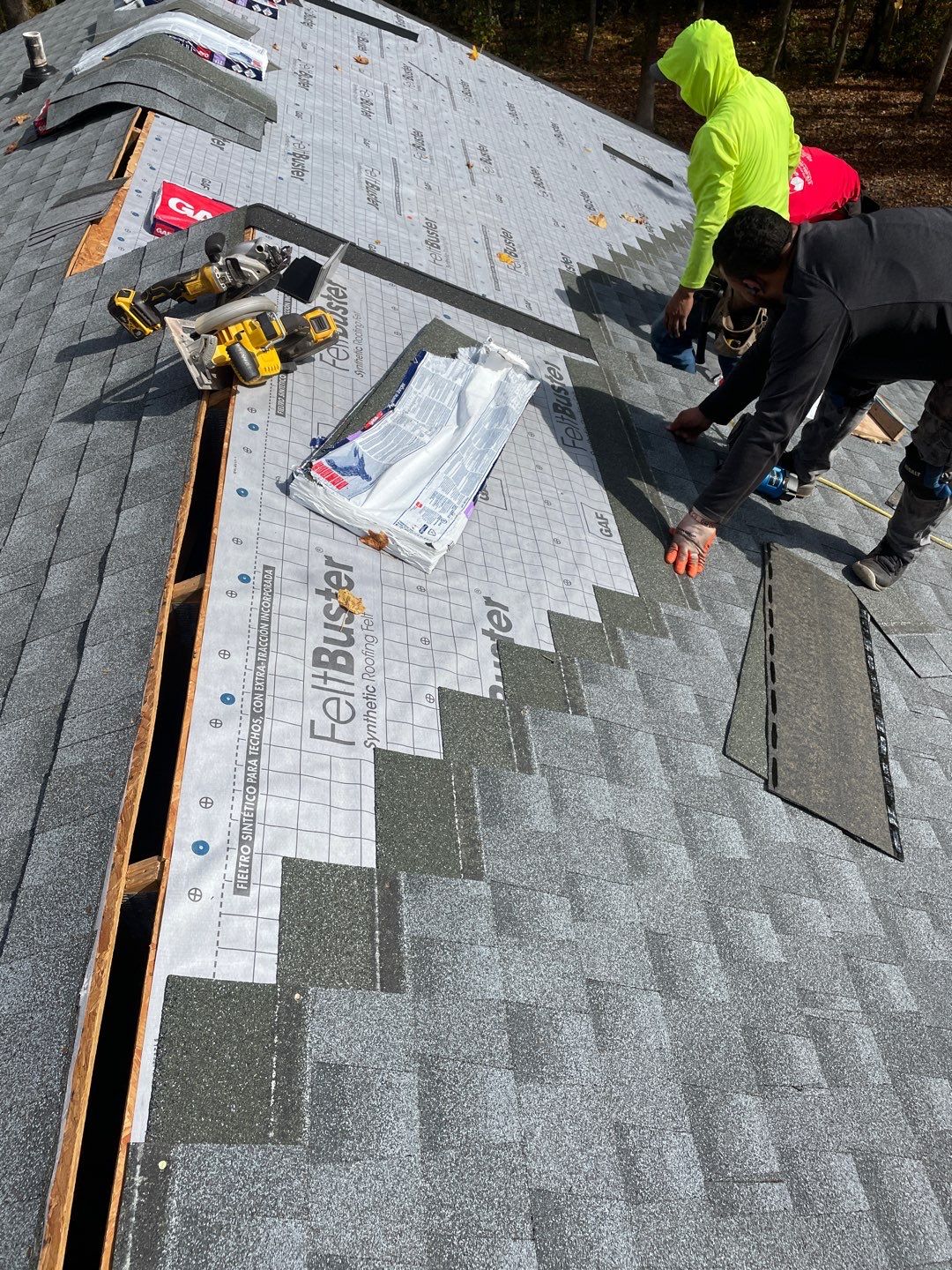Ideal Practices for Ensuring Proper Roof Air Flow
Guaranteeing appropriate roof air flow is important for the durability and effectiveness of a roof covering system. A well balanced consumption and exhaust vent proportion, commonly 1:300, plays a crucial duty, with intake vents preferably placed at the lower side of the roof for amazing air entrance and exhaust vents at the height for warm air leave. Normal inspections to determine obstructions and keep clear air movement are extremely important. Additionally, keeping insulation far from vents is essential to avoid air flow limitation. Comprehending these fundamental aspects sets the phase for more thorough understandings into installation and maintenance practices that can considerably improve your roof's efficiency.
Understand Air Flow Essentials
Properly recognizing air flow basics is crucial for guaranteeing the longevity and efficiency of roof. Reliable air flow alleviates moisture build-up and temperature extremes in the attic, both of which can result in significant structural damages over time. A well-ventilated roof covering assists in stopping common problems such as mold and mildew growth, timber rot, and ice dams, which can endanger the honesty of the roof covering products and the underlying structures.
The primary goal of air flow is to help with the motion of air, permitting a constant exchange between the outdoor and interior environments. This equilibrium is achieved with a mix of consumption and exhaust vents that work together to keep optimum air movement. Consumption vents, typically located along the soffits or eaves, enable fresh air to get in the attic room area, while exhaust vents, commonly positioned at or near the roofing ridge, allow hot, moist air to get away.
Key factors affecting the efficiency of roofing system ventilation include correct placement, appropriate sizing, and ensuring that both consumption and exhaust vents are unhampered. Routine inspection and upkeep are critical to identify potential blockages, damages, or ineffectiveness in the air flow system, consequently guarding the roofing system's efficiency and durability.
Kinds of Roofing Vents
Roof covering vents play a vital role in keeping reliable attic room ventilation and, by extension, the general health of the roofing system. Numerous kinds of roof vents are readily available, each with one-of-a-kind advantages customized to certain roof covering demands.

Soffit vents are installed under the eaves and operate in tandem with roof covering vents to make certain a balanced intake and exhaust system. By enabling cooler air to enter from below, soffit vents help with the expulsion of hot air with upper vents. Gable vents, situated on the outside wall surfaces of the attic, deal another effective solution, specifically in homes with saddleback roofs.
Evaluate Your Present Ventilation

Following, think about the age and condition of your roof products and air flow elements. Older systems may not comply with current building ordinance or may have weakened in time, reducing their performance. Conduct a complete assessment to determine any indications of damage, such as corrosion, damage, or spaces that could compromise the system's efficiency.
Additionally, measure the attic room temperature level and humidity levels. Heats and moisture can show inadequate air flow - gainesville roofing companies. Make use of a hygrometer and thermostat to get exact readings, contrasting them with exterior problems. Persistent inconsistencies recommend possible concerns that require attending to.
Installation Best Practices
Effective installation of roofing ventilation systems is extremely important for guaranteeing optimal efficiency and durability. Proper setup starts with understanding the particular air flow requirements of the building and the roof it covers. This involves computing the appropriate ratio of consumption to exhaust vents, typically adhering to the 1:300 policy, which states one square foot of air flow for every single 300 square feet of attic floor area.

The placement of vents is just as essential. Intake vents must be installed at the roofing system's reduced side, frequently in the soffits, to permit trendy air to get in. Exhaust vents, on the various other hand, should be mounted near or at the roofing's peak to facilitate the departure of cozy, wet air. This creates an all-natural air movement that helps keep temperature and moisture equilibrium within the attic room room.
Seal all vent links carefully to avoid air leaks and potential water infiltration. Usage premium products and comply with maker guidelines to guarantee toughness and performance. Furthermore, integrating ridge vents with baffles can significantly improve air movement effectiveness by avoiding wind-driven More Help rainfall and snow from getting in the attic room.
Eventually, exact installation of roof air flow systems minimizes prospective problems such as mold and mildew growth, ice dams, and structural damages, guaranteeing the roof's stability and the structure's overall health and wellness.
Routine Maintenance Tips
Uniformity in upkeep techniques is basic to ensuring the lasting effectiveness of roofing air flow systems. Normal evaluations are crucial, preferably executed biannually-- in the springtime and autumn. Throughout these examinations, make certain that vents are totally free of particles, nests, and other blockages that might impede air movement. Inspect for any type of indications of wetness build-up or mold, as these can show incorrect air flow or leakages (roofing companies).
Cleaning up the vents is an additional crucial job. Use a soft brush or a vacuum to remove dirt and particles from consumption and exhaust vents. Beware not to damage the air vent displays or louvers throughout the procedure. Furthermore, evaluate the attic room for any indicators of water damage, which might jeopardize the stability of the roof.
Appropriate insulation is similarly vital. Ensure that attic insulation does not block the vents, as this can seriously restrict airflow. If any insulation has moved or resolved, rearrange or replace it to preserve an effective barrier.
Last but not least, change any harmed or missing components without delay. Damaged vents, split shingles, or tatty blinking can all contribute to poor ventilation and ought roofing companies in gainesville florida to be attended to right away. Routine upkeep makes sure that the roofing ventilation system works efficiently, therefore extending the lifespan of the roofing itself.
Verdict
Making certain appropriate roof covering ventilation is vital for keeping the effectiveness and toughness of a roof system. Adherence to the 1:300 intake and exhaust vent ratio, paired with the tactical placement of vents, is vital. Routine biannual examinations, debris cleaning, and ensuring insulation does not block airflow are critical techniques. Implementing these ideal methods will certainly promote a well-ventilated roof, thereby minimizing prospective concerns associated with moisture buildup and too much heat, inevitably prolonging the roofing system's life-span.
A balanced intake and exhaust vent ratio, generally 1:300, plays a pivotal function, with intake vents ideally positioned website here at the lower edge of the roofing system for cool air entry and exhaust vents at the peak for cozy air departure. Intake vents, normally situated along the soffits or eaves, permit fresh air to get in the attic room area, while exhaust vents, usually located at or near the roof ridge, allow warm, moist air to run away.
Soffit vents are installed under the eaves and job in tandem with roof covering vents to ensure a balanced consumption and exhaust system. By permitting cooler air to enter from below, soffit vents assist in the expulsion of warm air through upper vents. Adherence to the 1:300 consumption and exhaust air vent proportion, coupled with the calculated placement of vents, is essential.